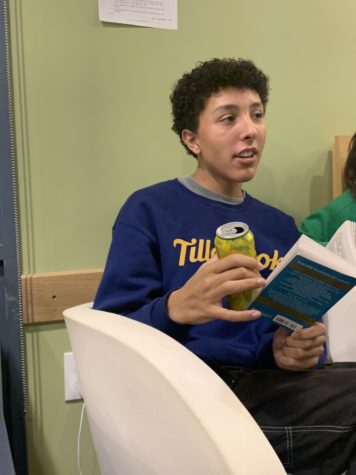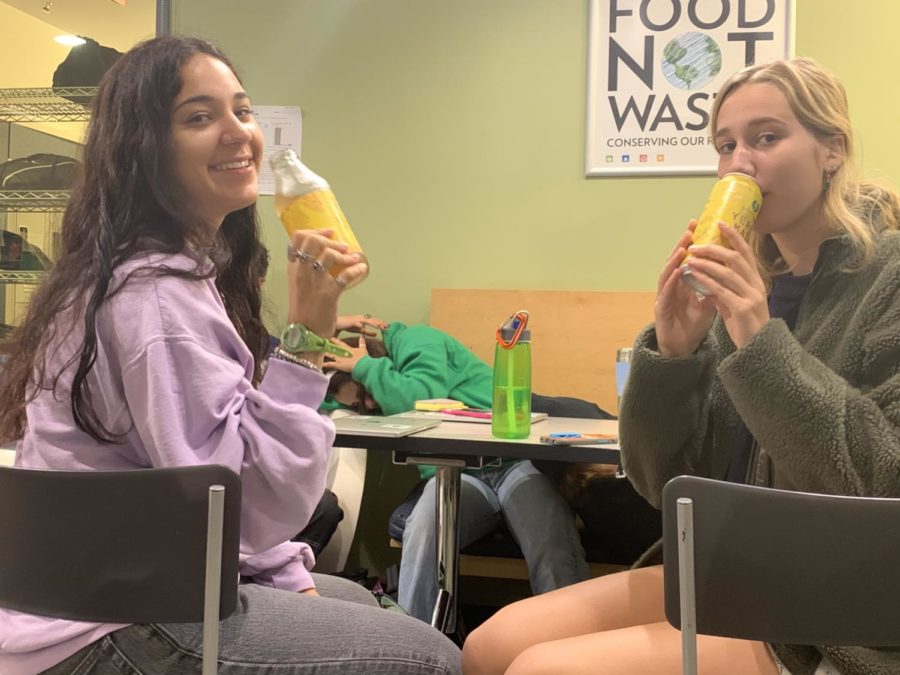Here’s the tea on Yerba Mates at Urban
Students Becky Phillips ’21 and Robyn Wadsworth ’21 drink Yerba Mates in the Student Center.

Keira Donahoe ’21 and Traylor Smith-Wallis ’21 enjoying Yerba Mate energy drinks. Photo credit: Clementine Daniels.
A Yerba Mate craze has spread across Urban following Flik’s decision to sell them this fall. The bottled or canned refreshing drink is made from the naturally caffeinated leaves of a species of holly that is native to the South American Atlantic rainforest. The Guayaki company explains that the sharing of traditional Yerba Mate tea in a gourd is said to be a sign of friendship and bonding, but the drink has taken on a completely new meaning in American culture: caffeine.
Before beginning to sell the teas on the Flik menu, Chef David Labao went into conversation with Charlotte to discuss whether they should be selling such highly caffeinated drinks, thus encouraging students’ caffeine consumption at Urban. There are about 140mg of caffeine in an average Yerba Mate can, and 80mg in the bottle. An average 8oz cup of coffee has about 80mg of caffeine, and the energy drink Red Bull has 111mg.
“Woah, I didn’t know that,” said Finn Budetti ‘20. “That’s crazy. I guess it makes me kind of scared — you don’t realize how strong they are.” Budetti started drinking Yerba Mates this year because they were more accessible than coffee, and because he liked the taste. He added that the caffeine dose from Yerba Mates feels different, and “it’s a whole lot easier to go through 3 Yerba Mates than coffees.”
Guayaki states that Yerba Mates have “the strength of coffee, the health benefits of tea, and the euphoria of chocolate, all in one beverage.” They add that the beverage contains 24 vitamins and minerals, 15 amino acids, and “abundant” polyphenols, which are micronutrients derived from certain plant-based foods. Urban Health Education teacher, Jennifer Epstein, is skeptical of Guayaki’s claim that the drink contains health benefits, and has noticed a large number of students drinking these “masked” caffeinated beverages in recent years.
“I am curious [about] the amount of caffeine that is being consumed by teenagers, [which] is probably way higher than it has been in the past, thanks to Starbucks and other coffee shops that sell these delicious sweet drinks,” Epstein said.
Chef David Labao explained that Flik decided to start selling the popular Yerba Mates when they realized how many students were going out to stores on Haight street to purchase the drink. “Why not bring it here?” he thought. “It’s good for business, and it’s good for [students] because it’s convenient.” He estimated that Flik sells about 100 Yerba Mates a day, and their weekly order consists of about 500 Yerba Mate bottles and cans.
Izzie Ballon ‘22 is a perfect example of how the availability of caffeine has affected her consumption. “Before [Yerba Mates] were sold at school, I would probably drink them once every two weeks or once a week,” she said. “Now, I drink it every day.” Ballon’s current favorite flavor is Lemon Elation, which comes in a can with 150mg of caffeine. In fact, she prefers to drink canned Yerba Mates because they have more caffeine. “Yesterday I had 300mg of caffeine, but on a daily average it’s probably like 150mg.
Epstein warns against the effects of caffeine on sleep and the reliance on caffeine to wake up instead of getting the appropriate amount of sleep; however, she recognizes sufficient sleep is difficult to attain. Caffeinated beverages used to be a section on the HIPE survey, which Epstein hopes to bring back this year.
While Budetti understands the concern that some adults and students might have about selling caffeinated drinks at Urban, he said “I think it makes sense to sell them because in general, most students consume caffeine on a day-to-day basis whether or not they’re sold at Urban.”
Ballon added, “how I focus in class is kind of dependent on [caffeine] now.” She found that while it wasn’t being forced on students, “now that it’s an option, people will drink it. More and more people are becoming dependent on caffeine.”


